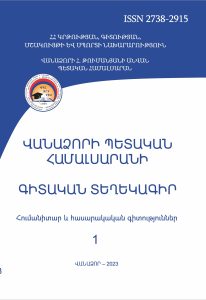Persian Borrowings in the Middle Armenian Language
Scientific Proceedings of Vanadzor State University Humanitarian and Social Sciences (ISSN 2738-2915)
2023 vol 1
Persian Borrowings in the Middle Armenian Language
Tereza Shahverdyan
Summary
 Key words: external means of vocabulary enrichment, direct and mediated word penetration, their frequency, spheres, homonyms in Armenian-Persian and Persian-other languages
Key words: external means of vocabulary enrichment, direct and mediated word penetration, their frequency, spheres, homonyms in Armenian-Persian and Persian-other languages
Vocabulary is a living organism and not a frozen reality which is constantly undergoing changes. New words are introduced and vocabulary is enriched. In Armenian, according to H.Acharyan’s “Root Dictionary”, a great number of borrowings were taken from Persian language – 1411. The article examines the Persian borrowings in Middle Armenian, according to the Middle Armenian dictionary, which includes the linguistic material evidenced in independent and translated works of the 12th-16th centuries, and partly of the 17th century. Studies confirm that Arabic borrowings are in the first place among Middle Armenian borrowings, although Persian borrowings are not few, but they are in the second place, they are 1037 in number. The number of informal borrowings from Persian is 1020, from Old Persian 22 words have passed into Middle Armenian. Authors express doubt about their origin of being Persian. A Particularly large number of Persian borrowings through Arabic is around 400 words. There are a large number of Persian-Turkish loanwords, their number is 96. The number of Persian-Arabic borrowings is 13 words, Turkish-Persian – 20 words, from Old Persian – 22, “probably” from Persian – 24.
The pattern of trilingual borrowings is as follows: Persian-Arabic-Turkish – 2, Arabic-Persian-Turkish – 94, Arabic-Turkish-Persian – 28, Turkish-Arabic-Persian – 1. These borrowings were made out of necessity and cover various fields: astronomy, medicine, botany, pharmacy, zoology. Homonyms are also interesting – about 70 words, have the same root, different root and word pairs borrowed from foreign languages and may sometimes be of three-syllable construction.
